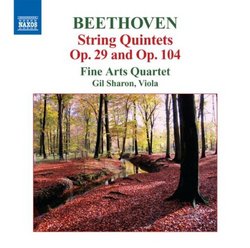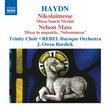| All Artists: Beethoven, Fine Arts Quartet, Sharon Title: String Quintets Members Wishing: 0 Total Copies: 0 Label: Naxos Original Release Date: 1/1/2010 Re-Release Date: 6/29/2010 Genre: Classical Style: Number of Discs: 1 SwapaCD Credits: 1 UPC: 747313222179 |
Search - Beethoven, Fine Arts Quartet, Sharon :: String Quintets
 | Beethoven, Fine Arts Quartet, Sharon String Quintets Genre: Classical
|
Larger Image |
CD DetailsSimilar CDs
|
CD ReviewsA Rare Beethoven Masterwork Robin Friedman | Washington, D.C. United States | 07/06/2010 (5 out of 5 stars) "Even with a composer of Beethoven's stature, some outstanding compositions do not get the attention they deserve. It is a delight to discover and to appreciate such rarities. Beethoven's String Quintet in C major, opus 29, is the leading example of an infrequently performed Beethoven masterwork. Scored for two violins, two violas, and cello, the Quintet is a radiant, lyrical work with soaring melodies for the first violin. The Quintet is relaxed and fun, looking back to Haydn and forward to Schubert. The Quintet dates from 1802, at about the time of the composition of the Second Symphony. It shares some of the character of this work, written during a particularly unhappy time in Beethoven's life.
In recent years, there has been a small revival of interest in Beethoven's String Quintet with new recordings, including a CD of Beethoven's complete music for String Quintet by the Zurich String Quintet. Beethoven: String Quintets (Box Set) This new recording of the String Quintet by the Fine Arts Quartet and violist Gil Sharon should encourage more listeners to get to know this work. They give a radiantly early romantic and gemuitlicheit reading to Beethoven's score. Founded in Chicago in 1946, the Fine Arts Quartet has served as quartet-in-residence at the University of Wisconsin -- Milwaukee for many years. I received my first exposure to string quartet music as an adolescent many years ago from live concerts by the Fine Arts Quartet and from their early LP cycle of the Beethoven Quartets. The members of the current quartet all joined the group well after the time in which I got to know the ensemble, but three of the members, violinists Ralph Evans and Elfim Boico and cellist Wolfgang Laufer have been playing together for over 25 years. Violist Chauncey Patterson is the newest member of this venerable quartet. The Opus 29 Quintet is in four movements and features intricate ensemble playing and counterpoint in addition to the solos for the first violin. The work opens with a leisurely Allegro moderato in which a lengthy, winding first theme is contrasted with a shorter and quieter secondary theme. There are many passages for the violin high in its register. The movement includes some surprising harmonic touches, including several Schubertian shifts between the major and minor key. Marked Adagio molto espressivo, the second movement features a lyrical, flowing slow theme first presented by the ensemble over a cello pizzicato. The flow of the movement is twice interrupted by surging, passionate minor key outbursts for a pleading violin soaring over the ensemble. There is an undertone of sadness to this movement, as to the Quintet as a whole. The third movement is a scherzo in which the solo violin playes over a rolling accompaniment including a drone-like figure in the cello. The trio consists of a cello solo lightly counterpointed by the violin. This short movement has a Haydnesque feel. The finale, Presto, has a perpetuum mobile feel, again similar to Haydn, but it is interrupted twice by a more reflective slow section. The rapid sections of the movement include large chords and a tremolo accompaniment supporting a rising theme in the violin. After the second return of the slow section, the Quintet works to a playful, triumphant and loud close. This CD also includes Beethoven's only other original work for String Quintet, a short fugue in D major, Opus 137 composed in 1817. This is a work of about two minutes in Beethoven's final, highly concentrated style of the last quartets and piano sonatas. The fugue is dense but lyrical and works to a serene conclusion. Beethoven also transcribed some of his other works into the medium of the String Quintet. The Fine Arts Quartet and violist Sharon round out this CD with Beethoven's late transcription of his early c minor piano trio, opus 1 no. 3. The piano trio was one of Beethoven's personal and idiomatic early works. Haydn tried to discourage the composer from publishing it. The transcription of the trio into a string quintet was done by a man named Kaufmann. Beethoven edited and modified Kaufmann's efforts substantially and published the resulting Quintet in c minor as his opus 104. While no match for the initial version, the transcription captures the tragic character of the work. With the exception of the lyrical variations in the second movement, the Quintet, and the trio on which it is based, remain for the most part in the key of c minor. The finale of this quintet with a long, wailing minor key theme is especially impressive. The ensemble gives a full-bodied passionate reading to this transcription of Beethoven's early piano trio. Lovers of Beethoven and of music slightly off the beaten track will enjoy getting to know Beethoven's lovely and unjustly neglected opus 29 String Quintet in C beautifully performed by the Fine Arts Quartet and Gil Sharon. Total Time: 72:44 Robin Friedman" |

 Track Listings (9) - Disc #1
Track Listings (9) - Disc #1

